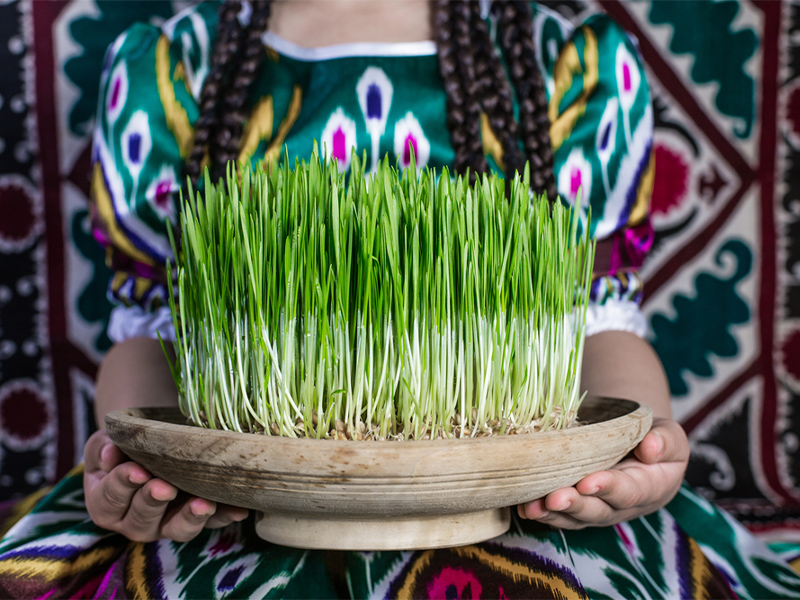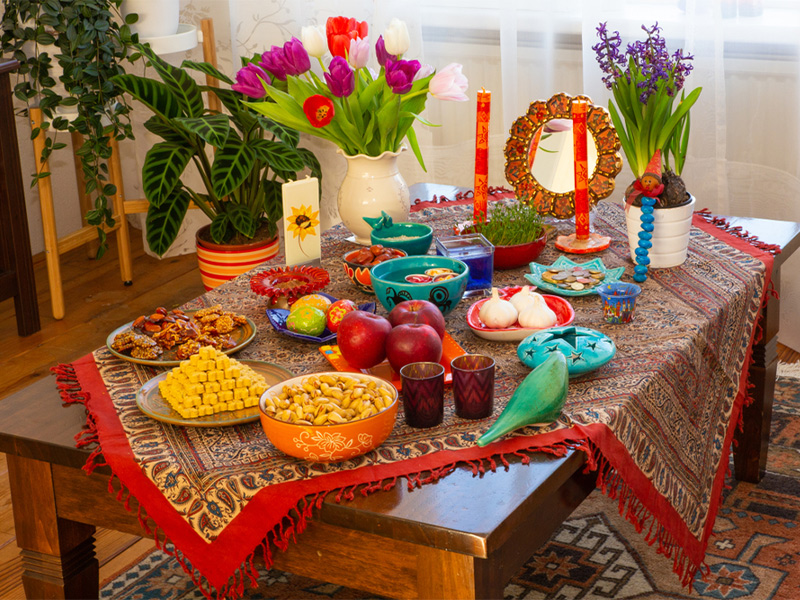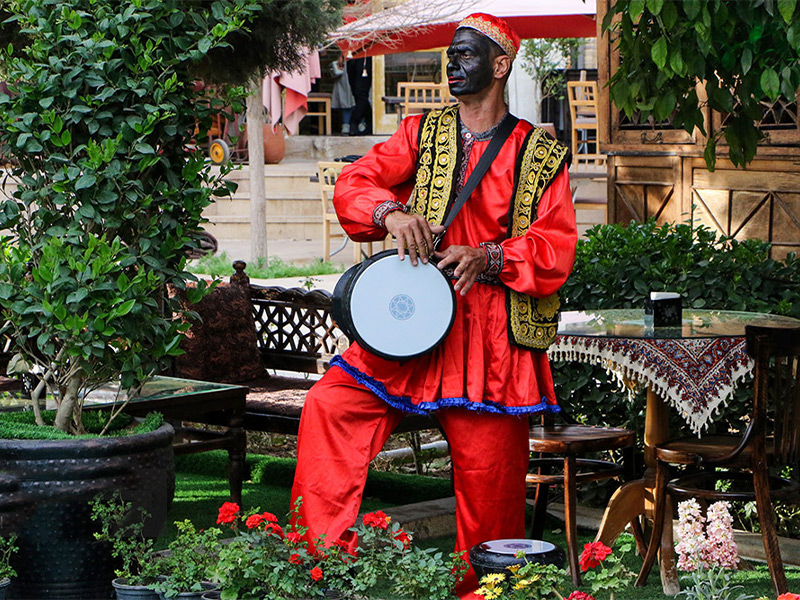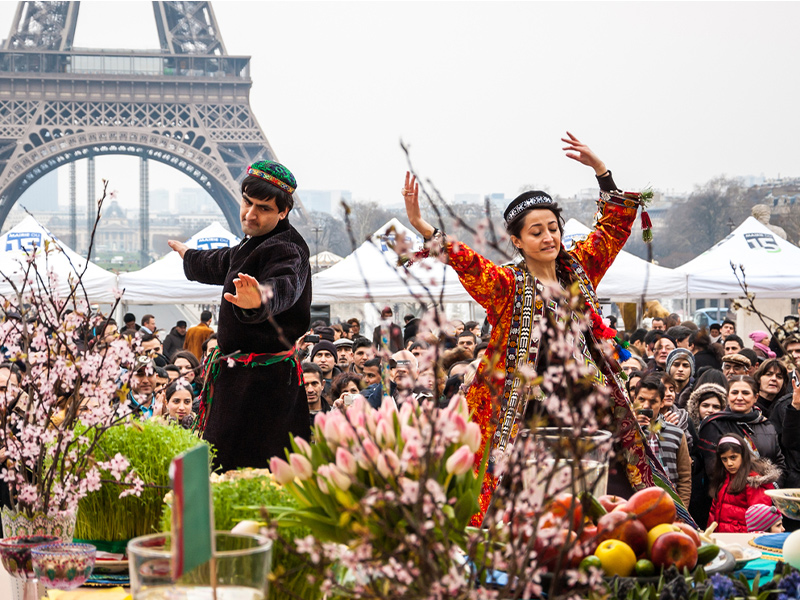Haft Seen spread during Nowruz is one of the oldest ceremonies in Iran. Nowruz, which means “new day” in Persian, is the traditional Iranian New Year celebrated by millions of people around the world. It marks the beginning of spring and is a time of renewal, joy, and hope. One of the most iconic aspects of Nowruz is the Haft Seen, a tabletop arrangement of seven symbolic items that represent different aspects of life and the coming year. In addition to Iran, most Persian-speaking neighbors also celebrate Nowruz, and the arrival of the spring season is filled with a sense of life and freshness for everyone. The Nowruz period in Iran lasts for 13 days, with each day having its own ceremonies and rituals.
The rituals and ceremonies of Nowruz have undergone significant changes from ancient times to the present, and some of them have even been forgotten. However, one ritual that has remained relatively unchanged over time is the arrangement of the Haft Seen spread. Join us as we explore the symbols and history of Haft Seen in this article from Eligasht Travel Magazine.
Book Iran Air flights from London to Tehran and Tehran to London with Eligasht UK:
About Nowruz
Nowruz is not only a time for celebration but also a time for storytelling and the sharing of ancient legends. Here are some fascinating stories and unknown secrets associated with Nowruz:
- The Legend of Jamshid: According to Persian mythology, King Jamshid was the legendary ruler who introduced Nowruz to the world. He possessed a magical cup that could reveal the secrets of the universe. On the day of Nowruz, he would fill the cup with the elixir of immortality and distribute it among his subjects, bringing them eternal youth and happiness.
- The Battle of Light and Darkness: Nowruz is believed to mark the victory of light over darkness. According to ancient Persian mythology, the god of light, Ahura Mazda, battled against the forces of darkness led by Ahriman. Nowruz symbolizes the triumph of good over evil and the renewal of hope and positivity.
- The Spirit of Haji Firuz: Haji Firuz is a beloved character associated with Nowruz. He is a jolly, black-faced minstrel who entertains people with his music and dances during the festivities. It is believed that his presence brings joy and laughter, driving away any remnants of winter and ushering in the spirit of spring.
Nowruz is not only celebrated in Iran but also in several other countries, including Afghanistan, Tajikistan, Azerbaijan, and parts of India and Pakistan. Each region adds its own unique customs and traditions to the celebration, making Nowruz a vibrant and diverse festival.
The History of Arranging the Haft Seen Spread
One of the oldest traditions of Nowruz that is still well-preserved is the arrangement of the Haft Seen spread. You may have wondered why it is called Haft Seen and where the significance of this number and ceremony comes from. Join us as we answer this question and delve deeper into the history of Haft Seen.
From ancient times, Iranians believed that if they possessed seven different elements, it would bring them luck and prosperity. Therefore, the number seven holds great value for the Iranian people. Another reason for choosing the number seven relates to astronomical matters, where people believed that by arranging the Haft Seen spread, they would cause the seven planets to revolve around the Earth. Of course, there are other theories and beliefs, which we will explore further.
The origins of Haft Seen can be traced back thousands of years to the ancient Persian civilization. It is believed that the tradition of setting up a special table for Nowruz dates back to the Achaemenid Empire, which ruled Persia from 550 to 330 BCE.
In ancient Iranian legends, it is said that Haft Seen represents the seven celestial angels. Each item on the Haft Seen spread symbolizes one angel, each with its unique moral characteristics. There are numerous narratives and stories about the naming of Haft Seen. Some also believe that Haft Seen represents seven different grains that were cultivated and harvested in Iran during the early days of Islam.
Haft Seen in the Past
In the past, the Haft Seen spread was placed on the ground or a wide table. The tables were elevated from the ground, and the arrangement of each item held significance. Interestingly, a wide white cloth was initially spread on each table, symbolizing purity, brightness, and the fight against impurity and darkness. The term “Khwan” in Persian refers to a table or a spread. The tables used by the people of Iran in the past were made of wood.
Haft Seen, Haft Shin, and Haft Chin!
It is interesting to note that, in the past, in addition to Haft Seen, Haft Shin, and Haft Chin were also arranged by the people. Haft Shin and Haft Chin were among the oldest ceremonies and traditions of ancient Iran, which, unfortunately, have been lost over time. The main reason for the abandonment of Haft Shin by the people of Iran was its contents. The main reason for the disappearance of Haft Chin was the absence of the letter “Ch” in the Arabic language, and it gradually disappeared from the tables of the Iranian people.
Main Elements of Haft Seen
Not everything that starts with the letter “Seen” (S) necessarily needs to be included in the Haft Seen spread. Arranging the Haft Seen spread has its own specific rules that are better to be followed, as it is one of the oldest ceremonies of ancient Iran that has remained with us. Having a Persian name and starting with the letter “Seen” (S) is one of the main requirements for the elements of Haft Seen.
Furthermore, everything placed on the Haft Seen spread should either be edible or made from plants. Another point is that whatever is placed on the Haft Seen spread should be a single word and not a combination of multiple words. Each of the main elements of Haft Seen is a symbol of something unlikely for the people of Iran to be unfamiliar with. Let’s explore these seven elements and what they represent:
Sir (Garlic): Garlic, known for its medicinal properties, symbolizes health and protection against evil spirits. It is also believed to ward off illness and negative energies.
Sabzeh (sprouts): Symbol of growth, progress, and purity. sabzeh is grown from lentils, wheat, or barley seeds and symbolizes the rejuvenation of nature
Sib (Apple): The apple represents beauty and fertility. It symbolizes the eternal youth and vitality of life. In Persian mythology, the apple is associated with immortality.
Senjed (oleaster): Symbol of love and affection. It is believed to have healing properties and is associated with wisdom and knowledge.
Sumac: Somaq, a crimson spice, symbolizes the color of the sunrise and represents the victory of light over darkness. It also signifies the zest and enthusiasm for life.
(Serkeh) Vinegar: Symbol of patience and eternity. It reminds people of the wisdom that comes with time and the importance of preserving traditions.
Samanoo: Made from sprouted wheat or barley, samanu signifies affluence and fertility. It is a symbol of sweetness and abundance in the coming year.
Sekkeh (Coins): One of the symbols of sustenance and livelihood.
Other Symbols on the Haft Seen Spread
In addition to the main elements of the Haft Seen spread that we have discussed and understood their symbols, other items are usually placed on the Haft Seen spread, each representing a specific concept or symbol. For example, one of the other symbols on the Haft Seen spread is a mirror. Placing a mirror next to the Haft Seen spread symbolizes purity and transparency. In fact, people have believed since ancient times that a mirror never tells lies, making it a symbol of honesty and clarity.
The candle is another symbol on the Haft Seen spread, representing the concept of light and overcoming darkness. The redfish, however, is one of those symbols that sparks debates every year about its necessity on the HaftSeen spread. Nevertheless, the redfish is a symbol of movement and liveliness, and whether to include it is up to personal preference. Other symbols used on the Haft Seen spread include the Quran, Shahnameh (the Persian epic), Divan-e Hafez (the poetry collection of Hafez), Saadi’s works, as well as coins, hyacinth, and tulip.
Related post
Final words
HaftSeen represents seven symbols of valuable concepts in Iranian culture. As we approach the days of Nowruz, it is better to start thinking about setting up your own Haft Seen spread. This tradition, which has been preserved from ancient Iran to the present day, is one of the most beautiful customs of Nowruz. Nowruz and the Haft Seen tradition hold deep cultural and historical significance. The Haft Seen table, with its seven symbolic items, represents various aspects of life and hopes for the coming year. Nowruz is a time of joy, renewal, and celebration, bringing people together to embrace the arrival of spring and the promise of a fresh start. The main Haft Seen elements are garlic, sprouts, apple, oleaster, sumac, vinegar, and saffron. In addition to these, other symbols such as a mirror and a candle can be included on the Haft Seen spread. Some also complete their HaftSeen spread by placing Shahnameh or Divan-e Hafez.

FAQ
1- What is Haft Seen?
HaftSeen is a traditional Persian practice of setting up a ceremonial spread in celebration of the Persian New Year, known as Nowruz. “Haft” means seven, and “Seen” refers to the letter “S” in the Persian alphabet. The spread typically includes seven symbolic items that start with the letter “S.”
2- What is the significance of Nowruz?
Nowruz holds great cultural and historical significance for the Persian people. It is a time to celebrate the arrival of spring, the renewal of nature, and the triumph of light over darkness. It is also a time for family and friends to come together, exchange gifts, and share joyous moments.
3- Why is the Haft Seen table important?
The Haft Seen table is a central element of the Nowruz celebrations. It represents the hopes and aspirations for the coming year. Each item on the table holds symbolic meaning and is believed to bring blessings and good fortune. The HaftSeen table serves as a reminder of the beauty of life and the importance of gratitude.
4- Are there any specific rituals associated with Nowruz?
Yes, there are several rituals associated with Nowruz. Some of these include jumping over bonfires to cleanse oneself of negative energy, visiting the graves of loved ones to pay respects, and participating in the Chaharshanbe Suri, a fire-jumping ceremony held on the eve of the last Wednesday before Nowruz.
5- What are some traditional foods eaten during Nowruz?
Nowruz is a time for feasting, and several traditional foods are enjoyed during this festive season. Some popular dishes include Sabzi Polo ba Mahi (herbed rice with fish), Ash Reshteh (a hearty noodle and bean soup), and Kuku Sabzi (an herb-packed frittata).
6- How is the Haft Seen spread traditionally arranged and displayed?
The HaftSeen spread is typically arranged on a sofreh (a special fabric spread) or a table. The items are carefully placed in a specific order, following aesthetic considerations and cultural traditions.
7- How long does Nowruz last?
Nowruz is celebrated for a period of 13 days. The first day of Nowruz marks the beginning of the new year, and the 13th day is known as Sizdah Bedar, a day when people go out into nature to picnic and enjoy the outdoors.

